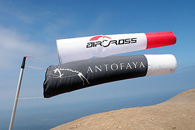

Tiliviche Canyon • San Marcos • Palo Buque • Junin Cliffs • Playa Cavancha • Alto Hospicio • Altos de Chipana • Iquique
Fly Atacama - Desert Paragliding Adventures - Iquique, Chile, November 2011
FLYING THE ATACAMA DESERT
Ned: I must admit, I was a bit stressed. I was already a day late, due to my hectic work schedule. After a delay in Dallas, I arrived in Santiago, Chile too late to make my connection to Iquique. So my plane touched down at the Iquique airport at 4:15 pm – two hours late. I didn't want to think about my buddies flying without me. Fortunately, I made my next flight – about a half hour later . . . with my paraglider.
I was met at the local airport by Jarek, and we were on the road within minutes. Six miles later, we left the highway and drove cross-desert to Palo Buque. A number of wings were already in the air. I zipped my flying suit over my travel clothes, found my radio and vario, and started kiting my wing up a small, sandy hill. Soon I felt a good thermal grab my wing – just as I hoped. Skidding along for a few feet to accommodate the gust, I checked my inflation, turned quickly, and was airborne! It was just after 5 pm.
After one trip back and forth on the little hill, I had enough altitude to cross to the main mountain, where I worked the lift, scratching back and forth over the soft sand. Two thousand feet above, I could see wispy little clouds starting to form. I kept scratching until I had 500 feet to play with, then headed out away from the mountain in search of real lift. I found sink instead. I kept my heading for a couple of minutes in minimal lift – and there it was! A bubble. Just tickling my outside wingtip. Turning that direction, I was soon coring a strong but smooth thermal.
Eight hundred feet up, it started to peter out, so I turned toward the mountain again. By then I was reaching the bottom of the cliffs, where I found the house thermals, and was soon at cloudbase, almost two thousand feet above launch. I flew south for a couple of miles to try to reach the Mystic Dunes, but with the goal in sight, I was defeated by moderate sink and strong headwinds. So it was back to Palo Buque to play. Not far below, Chuck had landed on the sand near the top of the mountain, just for fun.
After a while I could see the rest of the group starting to land by our vehicles. Time to come down. But I had lots of altitude to play with, so I headed toward the azure Pacific, two miles away. I figured I could take it on glide and still make it back to the vehicles with 300 feet of altitude. Not so. I was in that magic zone, just below the wispy clouds, the last thermals gently lifting off the desert as the cooler ocean air pushed in underneath. I was flying in zero sink! As I neared the ocean, I made a 180 and headed back over the LZ. Off to the west, a large orange sun was sinking into the sea. Far below, the vehicles looked like toys and the people like ants. A couple of the ants were waving their arms at me. I heard a voice on the radio starting to say, "Ned, Ned ..." in a Polish accent. I turned it off. I was the last man flying.
I started some aggressive turns to lose altitude. Then big ears. It was hard work to get down, but I'm a hard worker. I was only 300 feet up when my right wingtip lifted. I swear my glider started circling all by itself, with the vario singing happily in my ear. Yee-hah! I looked down, another thousand feet higher. The ants seemed agitated. So, reluctantly, I flew out of the lift, circled tightly for a while, and then it was time to land. Which I did, at dusk, just two hours after arrival.
I usually take one exotic paragliding trip each year. Previously, it was somewhere different each time. However, like Jarek, I seem to have settled on Iquique. And why not – it offers the best flying in the world! Smooth, consistent lift. Perfect temperature. Unlimited landing zones. The contrast between the blue Pacific Ocean and the stark beauty of the Atacama Desert. Great food. Great company. Friendly people. New flying sites each trip. And a high rise condo on the beach.
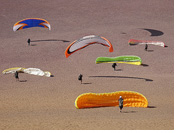 |
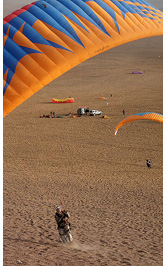 |
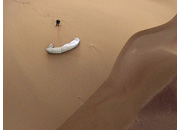 |
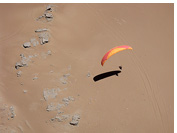 |
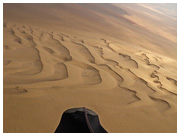 |
Chuck: November 8, 2011. Arriving at the airport in Iquique, Chile (about 1000 miles north of Santiago), we were met by our local guide, Jarek (Yar–eck). Jarek gave us the choice of going to Palo Buque, the nearby afternoon flying site, or directly to our condo in the city. After a long days' travel, we elected the condo, knowing there would be plenty of time to fly in the next 16 days. I'm rooming with Bruce Moffatt and Ned Israelsen, but Ned won't arrive until tomorrow. This is the third Iquique trip for each of us.
Our guides are Ken Hudonjorgensen of Two–Can Fly in Salt Lake area and Jarek Wieczorek of Antofaya Expeditions in Chile. They organize this trip each November. Ken was my original paragliding instructor, and is considered one of the grandfathers of the sport in the US. Jarek was born in Poland, worked as an internet entrepreneur in the US, quit young, and set off to find the best flying in the world. He found it in Iquique, and decided to stay. Now he lives there full time, flying most days when he's not backpacking in the Andes or guiding Patagonia glacier expeditions. Jarek knows the local flying as well as anyone, and has made several XC flights nearing 200 KM. Our two hard working van drivers, Daniel and Leo, are accomplished local pilots, helping to make our flying fun and easy.
In the morning, we drive up the nearby coastal range to Alto Hospicio, about 1600 feet above the city, where every pilot in town gathers. The launch is large and friendly. With no lift, it's a great morning sled ride site, with an easy glide to the closest beach. However, I'm holding out for the thermals. Just below the ridge is the huge Dragon Dune. Viewed from above it resembles a dragon's tail, about 700' tall and more than a mile long. Beyond the dune lies the city, then the ocean. All your weather knowledge will likely tell you this would NOT make for a good morning thermal flight: the ridge faces away from the sun, the ocean breeze should be breaking up the thermals, and it's kind of cloudy. Your weather knowledge would be wrong.
By 9:30, the turkey vultures are making big, lazy circles in front of launch, and by 10 we are flying, working our way along the consistent house thermals, heading a few miles to the north. We need to climb to about 2500' to assure a safe crossing at the widest part of the city. We absolutely MUST have sufficient altitude before we leave the trusty lift along the ridge, as there are NO landing options in the city. Once you leave for the beach, a couple of miles away, you're committed.
The thermals along the ridge were somewhat bumpy, but the city crossing was glassy smooth. There are several miles of landable beach. It's usually possible to glide out over the ocean before landing, where we often see seals or even manta rays playing in the surf. We landed on the beach just after noon, across from the condo. Bruce and I grabbed some lunch and headed back to the condo for a short nap. We were leaving for Palo Buque at 3 pm.
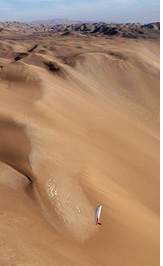 |
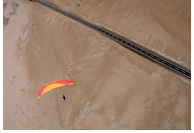 |
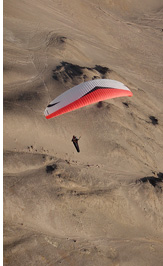 |
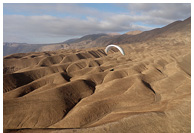 |
Palo Buque is a truly idyllic paragliding experience. Here, the coastal ridge rises to about 2000 feet, but most of the rocky terrain is covered in windblown sand, so it looks like a giant sand dune. It is actually a rocky ridge covered with 10 to 20 feet of soft sand, with a constant upslope breeze and smooth lift that you can ride indefinitely. From the bottom LZ, kiting up a small 100-foot-high ridge, the wind increases dramatically as you work your way up the ridge, so you'll usually launch before you even get to the top, then climb another 100 feet or so above the small ridgetop, where you'll be just high enough to cross over to the main mountain. There you can magically climb for miles and miles in smooth lift, hugging the sand all the way. The steeply sloping sand is so vast that you can easily lose perspective of whether you're even climbing or just crossing the ridge. You can choose to play in the sand, climb up to cloud base for a bit of XC, or fly out front for as much acro as you can stand, repeating the cycle at will for several hours. I usually do all the above, taking a break just before sunset to side-land on the sand, enjoy the changing colors as the sun sets, then glide down for a bit of mild acro to burn off altitude, landing just before it gets too dark to pack up.
It's a great place to learn: unlimited kiting area, uphill kiting practice, side-hill landing & launching, safe ridge scratching inches above soft sand, thermals, cloud-base play (rarely any more than big-ears required to stay out of the clouds), you can fly closer to the ground here than would normally be safe at other less forgiving sites. If you're brave enough to try some maneuvers, it's easy to get plenty of altitude and is a relatively safe place to throw a reserve, nothing to drop onto but sand, but definitely not as safe as over-water. Each year, I get a little closer to that perfect wingtip drag in the sand, but I love being able to do sliders across or down the dunes as I practice.
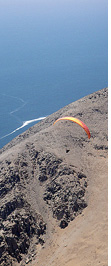 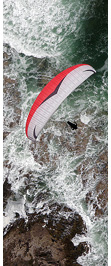 |
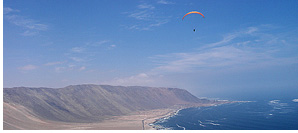 |
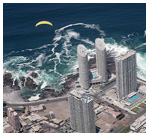 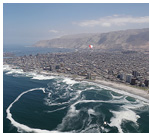 |
Ned: What a week! On day two, Ken, Jarek, and I flew 25 miles XC from Alto Hospicio, our morning launch, almost to the airport, then back to a lunch spot, Los Verdes, where we met up with the group for great seafood, fresh out of the ocean. Then on Saturday and Sunday, we drove to two sites: San Marcos, about 70 miles south, and Chipana, about 100 miles south. I flew a 50 mile XC from San Marcos, my personal best, back past the airport, past Los Verdes where Jarek landed, a few miles more to Palo Buque, and then (after a low save), back to Los Verdes for a late lunch. I was in the air just over 4 hours.
Now, on Monday, we were headed north. We met at 6:30 am and drove to Pisagua, a little fishing village almost 100 miles north of Iquique. Our morning launch, on the mountain just south of town was pretty windy, and high pressure kept a lid on things. However, I got up my courage, launched off the 2000-foot cliff, and had a fun one hour flight. In the quaint little village, we ate awesome ceviche and giant swordfish steaks at the local restaurant. Then it was off to the main event: Tiliviche Canyon, about 4 miles north of town. This is another site where you launch at the bottom and fly up.
Occasionally, Tiliviche Canyon has running water from the Andes. Today it was dry. We crossed the sandy riverbed in our trusty turbo-charged, 4-wheel-drive Mitsubishi vans and stopped at the bottom of a west-facing mountain, half a mile from the ocean. Shouldering our gliders, we hiked a hundred feet up a sandy slope. I was third to launch, and after a bit of scratching, I made it above the band of cliffs half way up the mountain.
The south side of the mountain facing the canyon was off limits, due to a dangerous venturi. However, it seemed the best lift was over that way. I flirted with the lift, just beyond the canyon, gaining another 600 feet. However, I soon reached the edge of my comfort zone. The thermals were small and sharp, and too close to the jagged cliffs. It's natural to head where the other pilots are having success. And when the lift is light, it's natural to scratch. Sometimes, though, it's best to go the other way. Which I did, putting some safe distance between me and the cliff. And then – BANG! It was a screamer of a thermal – 900 feet per minute! It started small and sharp, and I was banking hard, but as I popped up over the mountain, it mellowed and widened. Far below, I saw the other pilots leaving the cliffs and heading out front to my thermal.
Why is it such a thrill to be the top glider? I couldn't help but radio a couple of former top-of-the-stackers about how nice their gliders looked from above. My grin wouldn't stop. I headed further north, out front of where Ken was working some weak ridge lift just below the band of cliffs. Found another nice thermal and started circling tightly. The next thing I knew, Ken was there with me, and soon we were spinning tight circles in perfect unison, almost wingtip-to-wingtip in a dizzying ballet.
I bailed first as the thermal weakened, and found myself above an amazing plateau of a hundred undulating little peaks and dips stretching half a mile north and west. The late afternoon sun emphasized the colorful, jagged texture. The plateau sat atop a point that jutted west from the mountains all the way to the sea. I circled slowly, entranced by the beauty below. As I gained altitude bit by bit, an idea began to form. Could I go up the coast by flying over the plateau? Did I dare? What if I had to land in the middle of those badlands? I circled a bit higher. The wind was starting to shift south a bit – which would help push me across. But how would I ever get back, going all the way around the point with a headwind? Well, I could walk, couldn't I? So I went for it.
I made it over the plateau, but on the other side, I was sinking fast. I pushed full bar to cross the bowl on the lee side of the plateau, and headed for a slightly south-facing cliff. No lift there. Another minute and I would have to land. I scratched. Sank. Went further north – and found some lift, as you always do in the Atacama! I was out of sight of the rest of the gliders on the other side of the point, but as I climbed into view, they headed my way.
After I successfully flew back around the point and landed at sunset, Jarek told me that only two other pilots – experienced locals – had ever flown past the point. I had led a whole gaggle there.
Two days later I was on my way home. I flew higher, farther, and longer than I had on any other trip. In the course of a week, Ken and Jarek took us to seven different launches spanning 180 miles of amazing coastline. I flew every day – eight days all together – including my arrival and departure days. In fact, I have never been unable to fly in the Atacama. The lift is the most consistent I have ever flown. All this is what keeps me coming back.
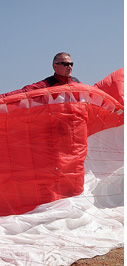 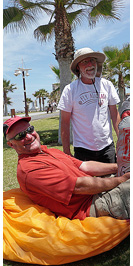 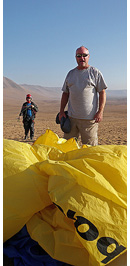 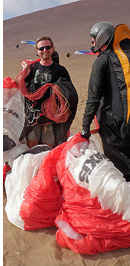 |
Chuck: Cross country flying is so easy here that even I give it a shot. We drove about an hour south of Iquique, headed up into the high desert, past the big salt mine, then another hour or more south, finally back towards the ocean. Our launch was over 2000' above Playa Chipana, a huge coastal plain below the ridge, and one HUGE LZ. The launch has sharp rocks, so we laid out a tarp to protect our wings. From here, it is possible to fly well over 100 miles north along the coast, but I am usually happy with about 20 miles or so. After a thorough briefing from Jarek on how to work the winds and terrain, and more importantly where NOT to go, we launch. Our group of about 8 works its way along the ridge, enjoying the view as much as the easy flying. We keep a constant eye on the ocean, as it will tell us when the winds are getting strong enough to create rotor zones around the rocky points that jut out into the sea.
The long distances here are possible when the winds behave and the lift stays strong enough for you to get high (5000' is high here) before crossing some of the gaps in the ridge. November is most favorable. The two most challenging gaps are called "cemeteries," as lots of flights end there. If the winds switch too far south, then the rotor zones also become obstacles to fly over, not through. When I got to a major point, 20 miles along, I turned south to check my groundspeed into the wind, and immediately knew that there would be strong rotor on the other side, so opted to ridge soar for a bit longer before landing. Several of us landed between the coastal highway and the surf zone, picking up some lifty bumps as we descended the last 200' or so into the soft sand. Our drivers were still over an hour away, as the only road back down to the highway is back around through the desert. While we waited, we hiked the beach, watched the sea lions and the sea life in the tidal pools. If you're a free diver, you can jump right in to hunt up your lunch of sea urchin or abalone. Every place you land here is an adventure in itself.
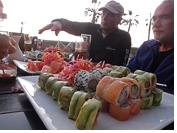 |
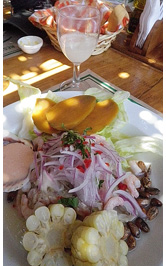 |
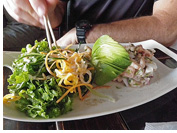 |
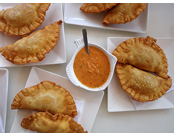 |
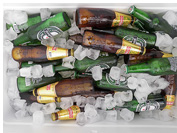 |
It virtually never rains here. A few misty clouds may form, but in November, cloudy days are usually good flying days. The rare vegetation you see in town is all irrigated, fed via pipeline from the far away Andean snow fields. Drive east and up to the desert - nothing whatsoever. No rain, people, vegetation, animals, birds, bugs. Nothing except sand and rock. When NASA needs to simulate Mars, they come here.
This is what makes Iquique such an amazing place to fly. The cold Humboldt Current that originates in Antarctica runs north along the coast. As the cool ocean air flows inland, it rolls over the warm coastal sand, then flows up the coastal ridge to create a seemingly never-ending mass of rising air. Instead of working to stay up in a thermal, it can be more work to get down. You rarely find huge strong thermals here, just lift everywhere. It's also rare to get above 4000 feet, but you can stay at the top of the lift all day. This allows long XC flights without the need for oxygen or heavy clothing.
I have never traveled to the Galapagos, though it is a place I would love to visit. There are places on Earth that we should all see, but because we help ruin them through the mere act of visiting them, we are probably better off just leaving them alone. Send a film crew, document it for all to see, then just don't go back. Iquique is sort of like that. I hate to tell anyone how wonderful it is, for fear they'll all want to go. Fortunately, in the vast Atacama, there is still plenty of empty space for flying.
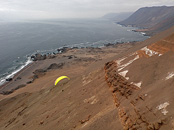 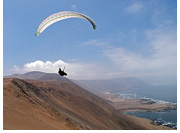 |
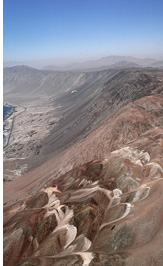 |
|
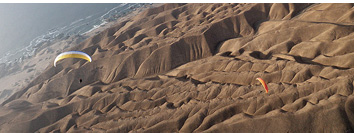 |
Ned: The Atacama desert is the driest place on earth. Iquique averages 0.6mm of rain per year - about two hundredths of an inch. In other places in the surrounding desert, it has not rained in recorded history. Studies of some riverbeds there suggest that they have been dry for 120,000 years. In much of the desert, there is no visible life. The 1976 Viking Mars probe found no life on the red planet. Using the same techniques, scientists were unable to detect any life in the drier areas of the Atacama - not even microbes. (More sophisticated techniques have now found a few microbes survive there.) However, despite the lack of rain, some life does exist in the west-facing coastal mountains. Certain lichens and even giant cacti have evolved to capture moisture from the frequent coastal fog.
About the authors:
Ned Israelsen is a patent attorney in San Diego, California. He comes to Iquique regularly.
Chuck Savall is a commercial airline pilot from Dillon, Colorado. He has been flying paragliders for 15 years and has flown in 7 different countries. He keeps going back to Iquique every year.
 |
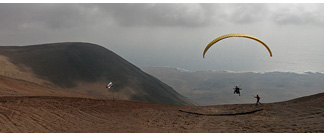 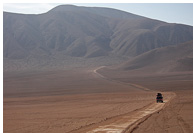 |
Jarek: We had a great time flying above the Atacama with everyone who came to Iquique in 2011. The proof is at the photos of all pilots' smiling faces at the Fly Atacama 2011 Daily Photoblog.
For the coming season dates of Fly Atacama Desert 2012 are set for 6-13 and 15-22 November. All pilots are welcome to join us for one or both weeks. In 2012 we plan to visit the same sites as 2011 (San Marcos, Alto Hospicio, Palo Buque, Altos de Chipana, Cliffs of Junin, Tiliviche Canyon) and may add a new record XC site far south called Level 2. We are always looking for new flying locations in the northern desert and will share the ones that work the best with our participants. For more information please contact:
• Jarek Wieczorek
tel. in the USA: (303) 800 6340
tel. in Chile: +56 9-8269-6562
website: www.antofaya.com
email: jarek@antofaya.com
Contact our guide to set up a custom itinerary in Chile or Argentina
About Antofaya | Overland and Trekking | Paragliding | Trip Galleries | Contact | Facebook ![]()
 |
Official importer and distributor in Chile of Alpacka packrafts and AirCross performance paragliders |
|
Site designed by Rianna Riegelman, riegelmanbookworks.com
All text and images found on this site, unless otherwise indicated,
are the property of Antofaya Expeditions and Digitalitis.com
2010 © Copyright Antofaya Expeditions
